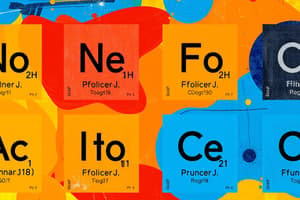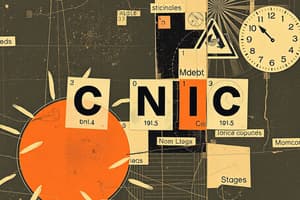Podcast
Questions and Answers
What is the correct naming convention for a simple cation in Type I Binary Ionic Compounds?
What is the correct naming convention for a simple cation in Type I Binary Ionic Compounds?
- The cation is named first followed by a prefix
- The cation name includes a Roman numeral
- The cation's name is the same as the element (correct)
- The cation is named with an –ide ending
Which of the following is a feature of Type II Binary Ionic Compounds?
Which of the following is a feature of Type II Binary Ionic Compounds?
- They follow the -ide ending for both cations and anions
- They are composed of metals that can form multiple cations (correct)
- They only contain nonmetals
- They do not use Roman numerals in their names
How is the anion named in Type I Binary Ionic Compounds?
How is the anion named in Type I Binary Ionic Compounds?
- With its full element name followed by a prefix
- With an –ide ending added to the element name (correct)
- By combining the names of both elements
- Using a Roman numeral to indicate its charge
What is the name of the compound represented by the formula FeI3?
What is the name of the compound represented by the formula FeI3?
In Type III Binary Compounds, what do the prefixes indicate?
In Type III Binary Compounds, what do the prefixes indicate?
What is the correct name for the compound CuBr2?
What is the correct name for the compound CuBr2?
What is the difference in nomenclature between Type I and Type II Binary Ionic Compounds?
What is the difference in nomenclature between Type I and Type II Binary Ionic Compounds?
Flashcards
Nomenclature
Nomenclature
The system scientists use to name compounds.
Binary Compounds
Binary Compounds
Compounds made up of two different elements only.
Type I Binary Ionic Compounds
Type I Binary Ionic Compounds
Composed of metals that can produce only one type of cation and an anion.
Naming Rule for Cation
Naming Rule for Cation
Signup and view all the flashcards
Naming Rule for Anion
Naming Rule for Anion
Signup and view all the flashcards
Type II Binary Ionic Compounds
Type II Binary Ionic Compounds
Signup and view all the flashcards
Common Type II Ions
Common Type II Ions
Signup and view all the flashcards
Type III Binary Compounds
Type III Binary Compounds
Signup and view all the flashcards
Study Notes
Nomenclature
- Nomenclature is the system scientists use to name compounds.
- Some compounds have common names, like water and ammonia.
- Most compounds follow naming rules based on the type of compound.
- Today's focus is on binary compounds, composed of two elements.
- Students should be able to name compounds from formulas and write formulas from names.
Type I Binary Ionic Compounds
- These compounds are formed from metals that only form one type of cation, and an anion.
- Cations commonly come from Groups 1, 2, and 13.
- Rules:
- The cation is named first, followed by the anion.
- Simple cations are named after the element.
- Simple anions are named by changing the element's ending to "-ide".
- Examples of Type I compounds:
- Sodium chloride = NaCl
- Magnesium chloride = MgCl₂
- Potassium oxide = K₂O
- Aluminum chloride = AlCl₃
- Lithium sulfide = Li₂S
- Calcium nitride = Ca₃N₂
Type II Binary Ionic Compounds
- These compounds are formed from metals that can form multiple cations, often transition metals.
- Rules:
- The cation is named by using the element name followed by a Roman numeral in parentheses indicating the charge.
- The anion is named by changing the element's ending to "-ide".
- Common Type II ions:
- Fe³⁺ = iron (III)
- Sn⁴⁺ = tin (IV)
- Fe²⁺ = iron (II)
- Sn²⁺ = tin (II)
- Cu²⁺ = copper (II)
- Pb⁴⁺ = lead (IV)
- Cu⁺ = copper (I)
- Co³⁺ = cobalt (III)
- Co²⁺ = cobalt (II)
- Pb²⁺ = lead (II)
- Hg²⁺ = mercury (II)
- Hg₂²⁺ = mercury (I)
- Examples:
- Copper (II) bromide = CuBr₂
- Copper (I) bromide = CuBr
- Iron (III) iodide = FeI₃
- Cobalt (III) oxide = Co₂O₃
Ion Chart
- Provides a table of common ions and their charges.
- Categorized by group on the periodic table.
Type III Binary Compounds
- These compounds are composed of two nonmetals held together by covalent bonds.
- Rules:
- The first element uses its full name.
- The second element is named as if it were an anion (ending in -ide).
- Prefixes are used to denote the number of atoms (mono-, di-, tri-, tetra-, penta-, hexa-, hepta-, octa-, nona-, deca-).
- The prefix "mono-" is not used for the first element.
- Examples:
- Carbon monoxide = CO
- Dinitrogen tetroxide = N₂O₄
- Trinitrogen pentoxide = N₃O₅
- Sulfur hexaoiodide = S₆
- Sulfur trioxide = SO₃
Polyatomic Ions
- Polyatomic ions are ions composed of more than one atom bonded together.
- Students must memorize these ions.
- Names are the same as type I binary ionic compounds.
- Subscripts are used outside parentheses when multiples of the same polyatomic ion are present.
- Examples of Polyatomic Ions:
- (with the appropriate charge):
- Acetate, Ammonium, Bicarbonate, Bromate, Carbonate, Chlorate, Chlorite, Chromate, Cyanide, Dichromate, Hydroxide, Hypoiodite, Iodate, Nitrate, Nitrite, Oxalate, Perchlorate, Permanganate, Peroxide, Phosphate, Phosphite, Sulfate, Sulfite, Thiosulfate
Naming with Polyatomic Ions
- Examples of compounds named using polyatomic ions:
- Sodium carbonate = Na₂CO₃
- Magnesium hydroxide = Mg(OH)₂
- Ammonium sulfate = (NH₄)₂SO₄
- Ammonium hydroxide = NH₄OH
- Barium nitrate = Ba(NO₃)₂
- Calcium hydroxide = Ca(OH)₂
- Aluminum nitrite = Al(NO₂)₃
Studying That Suits You
Use AI to generate personalized quizzes and flashcards to suit your learning preferences.




